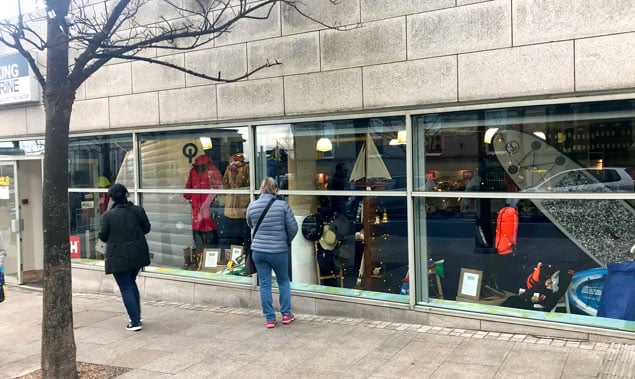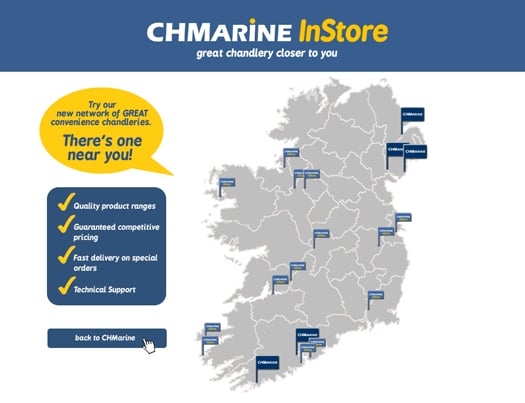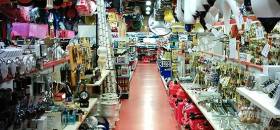Displaying items by tag: Chandlery
Viking Marine’s Black Friday Deals Now Available
Viking Marine’s Black Friday specials are now available — but be quick as these deals only last till Monday 26 November.
Get the best savings on selected Helly Hansen bags — with up to 50% off — and get 40% off the Wave Regatta Zhik Z-Cru Jacket.
Helly Hansen washbags (black only) and Jack Wolfskin backpacks are discounted by 30%, while you can save 15% on Seago Lifelines and Marine Pool Aero lifejackets, as well as International Cruiser 250 and Precision antifouling.
 Viking Marine's eye-catching Christmas Window display on Marine Road, Dun Laoghaire
Viking Marine's eye-catching Christmas Window display on Marine Road, Dun Laoghaire
In addition, there’s 10% off binoculars, the Seago offshore lifejacket, Seago inflatable danbury, and the Harken range.
All are available online and in store, with more daily promotions on offer in store at The Pavilion on Marine Road in the heart of Dun Laoghaire.
Be sure to follow Viking Marine on Facebook, Instagram and Twitter for the latest updates.
Make This Year’s Christmas One To Remember With Viking Marine
Christmas is less than six weeks away — but no need to fret, as Viking Marine has many wonderful gift ideas for all the sailors in your life.
Whether they’re only starting out or an ‘ancient mariner’, a dinghy enthusiast or yachting fanatic — you can find everything you’ll need for the perfect present in Viking Marine’s online gift guide.
To make your shopping experience even easier, Viking Marine has organised its guide by the type of sailor you’re looking to treat, whether that’s a dinghy sailor or racer, cruiser or offshore sailor.
Don’t miss the selection of stocking fillers for sailors of all stripes. And the new range open sea swimming gear from Orca will also appeal for those who brave the waters over winter.
Viking Marine Recruiting Full-Time & Part-Time Sales Assistants
Viking Marine is currently looking to recruit some hard-working and experienced sailing enthusiasts to work full time and part time as sales assistants in its Dun Laoghaire store.
If you are an experienced sailor with dinghy and yachts knowledge and are looking to share your passion with others, Viking Marine would love to hear from you.
Full details of the full-time and part-time sales assistant roles can be found on the Viking Marine website or click here.
To apply for either of these jobs, please e-mail your CV to [email protected]
All Eyes On Viking Marine’s Black Friday Deals
Viking Marine in Dun Laoghaire has something special in store for this year’s Black Friday sales.
Be sure to visit next Friday 23 November for exclusive savings and major discounts on clothing, safety equipment, boat hardware and more.
And be the first to know about Viking Marine’s Black Friday deals — as well as getting inditer tips on regular discounts, exclusive offers, sailing tips and more besides — by signing up for their email newsletter.
Follow Viking Marine on Facebook, Instagram and Twitter for the latest updates.
Western Marine of Dalkey in County Dublin celebrates fifty years in business in 2016 and marked its last day at its waterfront showrooms earlier this month. The landmark Dublin Bay premises has been sold and the long established Irish marine firm is relocating after 48 years at its Bulloch harbour site.
Doors closed in the Bulloch Harbour showrooms on April 2nd after a 'bonanza' relocation sale. A new location for the chandlery and boat sales store has yet to be announced. 'Details of our new location will be available shortly, but we can confirm we will not be moving very far!', managing director Hogan Magee told Afloat.ie
The conditions were ideal with a 7–knot breeze coming from the S.E. with flat water, blue skies and at the top of the tide. The harbour was looking its best.
The Race Officer set an excellent course. A bit of bias on the line made the start a bit interesting though. Class One got away clean. But Classes two and three had a General Recall.
After the start at Grassy the fleet had a beat out to No.3 The usual debate ensued over which side of the course was favoured. It was a close call in the end. Around No. 3 to starboard, spinnaker up and back to the Cage Bouy. A gybe and then on to No.12 at this stage there was a nice bit of ebb in the tide. It really was a case off keeping the Spinny flying for as long as possible up to the Mark. A nice beat followed, down to Corkbeg and then a nice reach back to the Grassy where the S flag was flying.
It was a good night for Billy Duane in his Sunlight 30 Expression in the White Sail fleet and for Jimmy Nyhan and Maritta Buwalda in their 1/4 Tonner Outrigger in Class 3.
First places also went to Thunderbird a Corby 25 owned by Denis Coleman in Class 2 and Endgame an A35 owned by Frank Doyle in Class 1.
CH Marine Launches New Chandlery Outlets Nationwide
June sees the official launch of a new concept in the marketing of marine equipment in Ireland.
Recognising that certain areas of Ireland are simply not able to support fully fledged marine stores on a year round basis, CH Marine has come up with the 'CH Marine Instore' concept.
This is a network of new micro- chandleries placed within existing businesses offering a range of the day to day requirements for boaters and sailors alike.
Typically, CH Marine Instore outlets are based in businesses such as Supermarkets, Service Stations, Hardware Stores and Boatyards located close to Ports or Marinas and where customers can stroll up for those simple supplies that are always needed on a boat. Life jackets and spares, marine cleaners and polishes, pumps and floats switches, rope and fenders are just some examples of the typical range of items that will be stocked.
CH Marine already supply a vast range of brand name marine products throughout Ireland, either through their own stores or through their network of Star dealers. The Instore program is seen as an extension of this network, improving service and providing an efficient supply to all areas of Ireland.
So far CH Marine has a network of 16 'Instores', eight of which are on the inland waterways. Full store listing here.
When Afloat.ie spoke to CH Marine's Managing Director, Nicholas Bendon, he explained that the recession had made it difficult to maintain a local supply in certain areas of Ireland and that INSTORE is solution to that problem. "The great thing about INSTORES is that they are true convenience stores and some, such as those in Supermarkets, are open 7 days a week.
They have all agreed to a ' price promise', ensuring that the prices charged will always be the same as CH Marine and there is a back up support of next day delivery on the vast range of CH Marine standard stock items "
Having piloted the scheme last year, CH Marine currently have 16 signed up Instore outlets but the list is expanding and a total of 50 is envisaged.

For more info on your nearest CH Marine Instore outlet - click www.chmarine.com/instore



































































